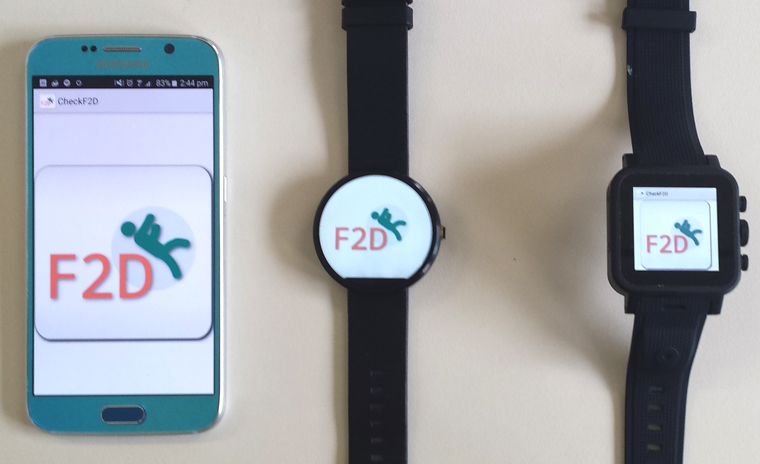F2D
 |
2014-2015. Fall detection with a smartwatch. |
F2D is a fall detection system running on a smartwatch. Unlike traditional systems that need a base station and an alarm central, F2D works completely independently, protecting so its user at home but also outside. It uses the current context as well as the user profile to offer more accuracy in the fall detection process. Running on a standard smartwatch, F2D is less stigmatising for the user and it can be offered for less than half the price of existing systems on the market. F2D is a CTI project in which the TaM R&D group of the University of Geneva is collaborating with the Fondation Suisse pour les Téléthèses.

Our system uses the tri-axial accelerometer signal which is the most informative sensor regarding the fall detection. On top of an innovative threshold based algorithm, we built a global solution allowing contextual data to be taken in consideration. Information like the location of the user allows the carer to give support much faster by knowing where the fall occurred. A user profile allows personal fine tuning of the algorithm. We can therefore adapt it based on the habits or wishes of the user.

In more technical terms, the TaM group implemented a Java library that detects falls with great sensitivity and specificity. During the F2D CTI project, we focused the development on an Android smartwatch model Simvalley AW-420.RX. However, as it is a standard Java library, any system able to run Java and collect tri-axial accelerometer data (Android phones, Android smartwatch, Android Wear smartwatch, etc.) is able to run F2D.
Choosing a smartwatch as main device adds significant advantages over more traditional systems, like a sensor belt. Firstly, some of the targeted users also need other applications, like for instance a geofencing app, and regrouping all these on a single device is of course quite practical.
Secondly, using a smartwatch allows the system to work in a bigger area. Indeed, a classical system is usually composed of a wearable device (to detect the fall) connected wirelessly to a base station (to transmit the alarm). But this works only when the user isn't too far from the base station. If the user falls in his garden or while walking towards the opposite end of the retirement home (to visit a friend), the system couldn't work correctly.
Thirdly, F2D is a solution that is simple to deploy, to manage, and that is significantly cheaper since the only hardware we need is a mass-market smartwatch (average smartwatch price is about 300 CHF). Also for the end-users the advantage is that the solution is much less stigmatizing, since a smartwatch is worn mostly by young and healthy people.
Bonus: A shot of Panagiotis Kostopoulos testing his algorithm in our lab:

Publications
- Increased Fall Detection Accuracy in an Accelerometer-Based Algorithm Considering Residual Movement
- F2D: A fall detection system tested with real data from daily life of elderly people
- F2D: A location aware fall detection system tested with real data from daily life of elderly people
